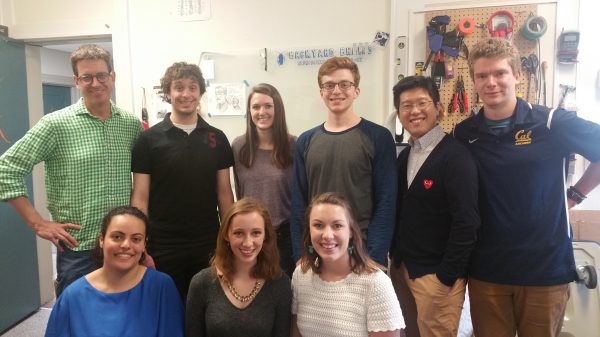-
 BYB Neuroscience NewsKafka couldn’t have imagined it better. Two specimens of the cockroach phylum were going about their business in a Myanmar cave about 99 million years ago. One day they got trapped in tree resin, which then turned to amber and preserved their little bodies to this day to tell us an impressive tale of time, […]
BYB Neuroscience NewsKafka couldn’t have imagined it better. Two specimens of the cockroach phylum were going about their business in a Myanmar cave about 99 million years ago. One day they got trapped in tree resin, which then turned to amber and preserved their little bodies to this day to tell us an impressive tale of time, […] -
 EducationBackyard Brains is live from inside the classroom of Colegio Alberto Blest Gana in Santiago to present you 5 group projects brought to life by creative and passionate students. and the methodology we used to choose the projects. This high school has been like a second lab for Backyard Brains, where the students beta test […]
EducationBackyard Brains is live from inside the classroom of Colegio Alberto Blest Gana in Santiago to present you 5 group projects brought to life by creative and passionate students. and the methodology we used to choose the projects. This high school has been like a second lab for Backyard Brains, where the students beta test […] -
 EducationIt’s early on a warm Ann Arbor morning and the office is buzzing with excitement! Our Summer 2017 research fellows are here! Today, our fellows are getting to know the staff and space at Backyard Brains, but more importantly, they’re planning, because for the next ten weeks they will be working on neuroscience and engineering […]
EducationIt’s early on a warm Ann Arbor morning and the office is buzzing with excitement! Our Summer 2017 research fellows are here! Today, our fellows are getting to know the staff and space at Backyard Brains, but more importantly, they’re planning, because for the next ten weeks they will be working on neuroscience and engineering […] -
 EducationIn case you’re unfamiliar with Backyard Brains, we like Cockroaches. You might even say we love them. Cockroach’s are hardy insects with a knack for neuroscience and performance. The cockroaches we work with are known as Blaberus Discoidalis or False Death’s Head cockroaches (among many common names). They are often bred for reptile food but we […]
EducationIn case you’re unfamiliar with Backyard Brains, we like Cockroaches. You might even say we love them. Cockroach’s are hardy insects with a knack for neuroscience and performance. The cockroaches we work with are known as Blaberus Discoidalis or False Death’s Head cockroaches (among many common names). They are often bred for reptile food but we […] -
 EducationTired of having to dampen those sponges, and adding fresh potatoes for your cockroaches during these dry winter months? Well, this may be the solution for you. Here’s what you’ll need: Twine (We borrowed some from Colin Stoetzner’s science video art project) Shampoo/Mouthwash sampler bottle Pair of Scissors Cockroaches (Optional) Simply poke a hole in the top of the bottle, […]
EducationTired of having to dampen those sponges, and adding fresh potatoes for your cockroaches during these dry winter months? Well, this may be the solution for you. Here’s what you’ll need: Twine (We borrowed some from Colin Stoetzner’s science video art project) Shampoo/Mouthwash sampler bottle Pair of Scissors Cockroaches (Optional) Simply poke a hole in the top of the bottle, […] -
 EducationWe currently have used American Cockroaches (Periplaneta americana) in our experiments, but we have to order them from Carolina Biological Supply in North Carolina, and they are a bit expensive due to live animal shipping charges. No angst towards that fantastic company, but we have been looking for a local supplier that can give us […]
EducationWe currently have used American Cockroaches (Periplaneta americana) in our experiments, but we have to order them from Carolina Biological Supply in North Carolina, and they are a bit expensive due to live animal shipping charges. No angst towards that fantastic company, but we have been looking for a local supplier that can give us […] -
OLPCBackyard Brains is beginning to make in-roads with the OLPC (One Laptop Per Child) initiative. This week we were able to display spike waveforms from a cockroach leg in real-time on the OLPC laptop. We are using the “Measure” application to display the data. Note the spikes on the XO PC below from our prototype […]
